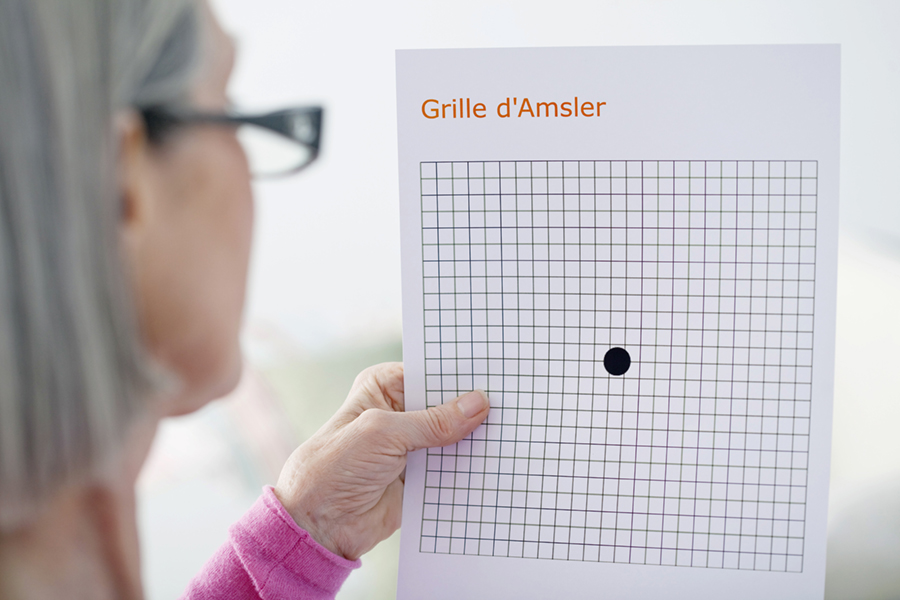Macular Degeneration is an eye disease affecting the macula (the center of the light-sensitive retina at the back of the eye), causing loss of central vision.
Age-Related Macular Degeneration (AMD) is the leading cause of severe vision loss in adults over age 50. The Centers for Disease Control and Prevention estimate that 1.8 million people have AMD and another 7.3 million are at substantial risk for vision loss from AMD. Caucasians are at higher risk for developing AMD than other races. Women also develop AMD at an earlier age than men. This eye disease occurs when there are changes to the macula, a small portion of the retina that is located on the inside back layer of the eye. AMD is a loss of central vision that can occur in two forms: “dry” (atrophic) and “wet” (exudative). Most people with macular degeneration have the dry form. While there is no specific treatment for dry AMD, studies have shown a potential benefit from vitamin supplements, a Mediterranean diet, protection from the ultraviolet light of the sun and cessation of smoking. The less common wet form may respond to intraocular injections of anti-VEGF medications if detected and treated early.

Causes & risk factors
- Heredity.
- UV Light exposure.
- Smoking.
- Poor nutrition.
- Lack of exercise.
Symptoms
In its early stages, the following signs of macular degeneration can go unnoticed.
- The gradual loss of ability to see objects clearly.
- The shape of objects appears distorted.
- Straight lines look wavy or crooked.
- Loss of clear color vision.
- A dark or empty area in the center of vision.
Diagnosis
If experiencing any of the above signs or symptoms, contact a doctor of optometry immediately for a comprehensive eye examination. Tests will determine if one has macular degeneration or any other eye health problems. A doctor of optometry can also provide a simple take-home screening test called an Amsler Grid. Central vision that is lost to macular degeneration cannot be restored. However, low-vision devices, such as telescopic and microscopic lenses, can maximize existing vision.

Treatment
With “dry” macular degeneration, the tissue of the macula gradually becomes thin and stops working properly. There is no cure for dry AMD, and any loss in central vision cannot be restored. However, researchers and doctors believe there is a link between nutrition and the progression of dry AMD. Making dietary changes and taking nutritional supplements can slow vision loss. Less common, “wet” macular degeneration occurs when fluids leak from newly formed blood vessels under the macula. This leakage blurs central vision. Vision loss can be rapid and severe. If detected early, wet AMD can be treated with intraocular injections of anti-VEGF medications. Researchers have linked eye-friendly nutrients such as lutein and zeaxanthin, omega 3 supplements or consumption of fatty fishes, vitamin C, vitamin E and zinc to reducing the risk of certain eye diseases, including macular degeneration. For more information on the importance of good nutrition and eye health, please see the diet and nutrition section.
Prevention
- UV protective glasses.
- Cardiovascular health and exercise.
- Properly controlling and monitoring diabetes and hypertension.
- No use of tobacco products (cigarettes, cigars, vapes, etc.)
Nutrition and AMD
There’s no substitute for the quality of life good vision offers. Adding certain nutrients to a diet every day—either through foods or supplements—can help save the patient’s vision. In a large human clinical trial, AgeRelated Eye Disease Study (AREDS2) by the National Eye Institute Researchers, linked lutein and zeaxanthin, omega 3, vitamin C, vitamin E and zinc to reducing the risk of AMD.
Lutein and Zeaxanthin—Need 10 mg lutein and 2 mg zeaxanthin per day to slow AMD progression
Lutein and zeaxanthin are found in green leafy vegetables as well as other foods such as eggs. Many studies have shown that lutein and zeaxanthin reduce the risk of chronic eye diseases, including AMD.
Vitamin C—Need 500 mg per day to slow AMD progression
Scientific evidence suggests vitamin C, when taken with other essential nutrients, can slow the progression of AMD and visual acuity loss. The first AREDS clinical trial, AREDS1, established AMD as a “nutrition-responsive disorder.” The study showed that taking 500 mg/day of vitamin C, along with antioxidants beta-carotene, vitamin E and zinc, slows the progression of AMD by about 25%. Seven smaller studies have confirmed these results.
Vitamin E—Need 400 mg per day to slow AMD progression
AREDS showed that taking 400 IU/day of vitamin E, along with antioxidants beta-carotene, vitamin C and zinc supplementation, slows the progression of AMD by about 25% in individuals at high risk for the disease.
Zinc—Need 40 to 80 mg daily to slow AMD progression
AREDS showed that taking 40-80 mg/day of zinc, along with antioxidants beta-carotene, vitamin E and vitamin C, slows the progression of AMD by about 25% and visual acuity loss by 19 % in individuals at high risk for the disease. Higher levels of zinc may interfere with copper absorption, which is why the people in the AREDS study also took a copper supplement. Omega 3s need study data for recommended dosage and types.
